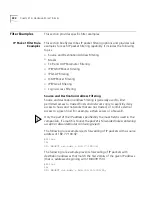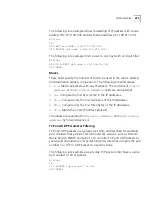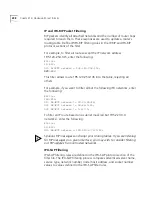
224
C
HAPTER
14: H
ANDLING
P
ACKET
F
ILTERS
Specifying the Filtering Action
You can specify the filtering action for each protocol section that
determines whether a packet is accepted or rejected if no match occurs
with any of the rules defined in the section. To do so, enter one of the
following values as the
last
rule line of the section:
■
ACCEPT
■
DENY
For example, the following entry would reject IP packets that did not
match any of the rules defined in the IP protocol section:
#filter
IP:
010 ACCEPT tcp-dst-port> = 24;
020 ACCEPT src-addr = 128.100.033.001;
030 ACCEPT dst-addr = 200.135.038.009;
040 DENY;
If you do not specify a filtering action, the default filtering action is
permit
.
Creating Filter Files
To create a filter, use a text editor on your computer to create or edit a
filter file. Use the Trivial File Transfer Protocol (TFTP) to load the file in the
RAS 1500 FLASH memory. (If you TFTP an edited file to the RAS 1500, it
replaces the original file.)
Be careful, the following steps require frequent switching between your
computer and the RAS 1500. To create a filter file on your computer,
perform the following:
1
Create a new text file. Enter a file descriptor on the first line.
#filter
Eliminate blank space before the descriptor, otherwise an error will occur.
2
Enter a file section header followed by a colon to begin a protocol
section. For example, to define IP filtering rules, enter the following
section header:
IP:
If you want to comment a section header out, put a
#
(pound) sign
before the header. It is useful to insert a placeholder for a protocol
section you will define later.
Summary of Contents for REMOTE ACCESS SYSTEM 1500
Page 14: ......
Page 40: ......
Page 58: ......
Page 120: ......
Page 130: ......
Page 158: ......
Page 178: ......
Page 202: ......
Page 266: ......
Page 286: ......
Page 292: ......
Page 297: ...INDEX 295 V 90 151 W Windows 95 Dial Up Networking 89 World Wide Web WWW 285 X X 75 152 ...
Page 298: ...296 INDEX ...
















































